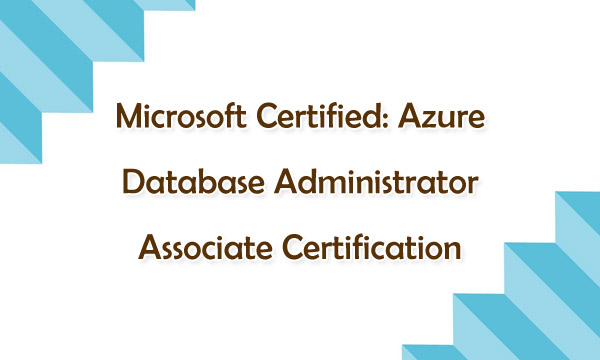Microsoft Certified: Azure Database Administrator Associate Certification
March 19,2021 01:52 AM
Microsoft Certified: Azure Database Administrator Associate certification is much hot among those Microsoft candidates. We all know that DP-300 exam is a required test for this certification. Candidates for this Microsoft DP-300 exam are database administrators and data management specialists that manage on-premises and cloud relational databases built with Microsoft SQL Server and Microsoft Azure Data Services. We just updated Microsoft certification DP-300 exam dumps questions, which are valuable for you prepare this DP-300 exam.

Microsoft Certification DP-300 Exam
To take Microsoft certification DP-300 exam, you should understand all concepts covered in Exam DP-900 Microsoft Azure Data Fundamentals. The Azure Database Administrator uses a variety of methods and tools to perform day-to-day operations, including applying knowledge of using T-SQL for administrative management purposes. There are 40-60 questions in real Microsoft certification DP-300 exam. The test languages are English, Chinese (Simplified), Japanese, Korean.
DP-300 Administering Relational Databases on Microsoft Azure Skills
Microsoft certification DP-300 exam skills cover the following details.
Plan and implement data platform resources (15-20%)
Implement a secure environment (15-20%)
Monitor and optimize operational resources (15-20%)
Optimize query performance (5-10%)
Perform automation of tasks (10-15%)
Plan and implement a High Availability and Disaster Recovery (HADR) environment (15-20%)
Perform administration by using T-SQL (10-15%)
Practice Updated Microsoft DP-300 Exam Dumps
New updated Administering Relational Databases on Microsoft Azure DP-300 exam dumps can help you test all the above exam skills. Share some updated Microsoft certification DP-300 exam dumps questions below.
1.You have a Microsoft SQL Server 2019 instance in an on-premises datacenter. The instance contains a 4-TB database named DB1. You plan to migrate DB1 to an Azure SQL Database managed instance. What should you use to minimize downtime and data loss during the migration?
A. distributed availability groups
B. database mirroring
C. log shipping
D. Database Migration Assistant
Answer: A
2.You have an Azure SQL Database managed instance named SQLMI1. A Microsoft SQL Server Agent job runs on SQLMI1. You need to ensure that an automatic email notification is sent once the job completes. What should you include in the solution?
A. From SQL Server Configuration Manager (SSMS), enable SQL Server Agent
B. From SQL Server Management Studio (SSMS), run sp_set_sqlagent_properties
C. From SQL Server Management Studio (SSMS), create a Database Mail profile
D. From the Azure portal, create an Azure Monitor action group that has an Email/SMS/Push/Voice action
Answer: C
3.You are building a database backup solution for a SQL Server database hosted on an Azure virtual machine. In the event of an Azure regional outage, you need to be able to restore the database backups. The solution must minimize costs. Which type of storage accounts should you use for the backups?
A. locally-redundant storage (LRS)
B. read-access geo-redundant storage (RA-GRS)
C. zone-redundant storage (ZRS)
D. geo-redundant storage
Answer: B
4.You have an Azure SQL Database server named sqlsrv1 that hosts 10 Azure SQL databases. The databases perform slower than expected. You need to identify whether the performance issue relates to the use of tempdb on sqlsrv1. What should you do?
A. Run Query Store-based queries
B. Review information provided by SQL Server Profiler-based traces
C. Review information provided by Query Performance Insight
D. Run dynamic management view-based queries
Answer: D
5.You have an Azure SQL database. Users report that the executions of a stored procedure are slower than usual. You suspect that a regressed query is causing the performance issue. You need to view the query execution plan to verify whether a regressed query is causing the issue. The solution must minimize effort. What should you use?
A. Performance Recommendations in the Azure portal
B. Extended Events in Microsoft SQL Server Management Studio (SSMS)
C. Query Store in Microsoft SQL Server Management Studio (SSMS)
D. Query Performance Insight in the Azure portal
Answer: C
DP-300 Exam Dumps PDF & SOFT | 1 Year Free Update | Money Back Guarantee
- Related Suggestion
- How to Achieve the CP1 Cathodic Protection Tester Certification? December 22,2023
- CFPS Certified Fire Protection Specialist Exam Dumps Available November 13,2023
- Microsoft: Innovations and Certifications in 2023 April 12,2023
- Best Approach to Pass AZ-400 Exam March 05,2019
- Microsoft SQL Server 2016 Certification Updates: Guides and Exam Dumps January 06,2018

